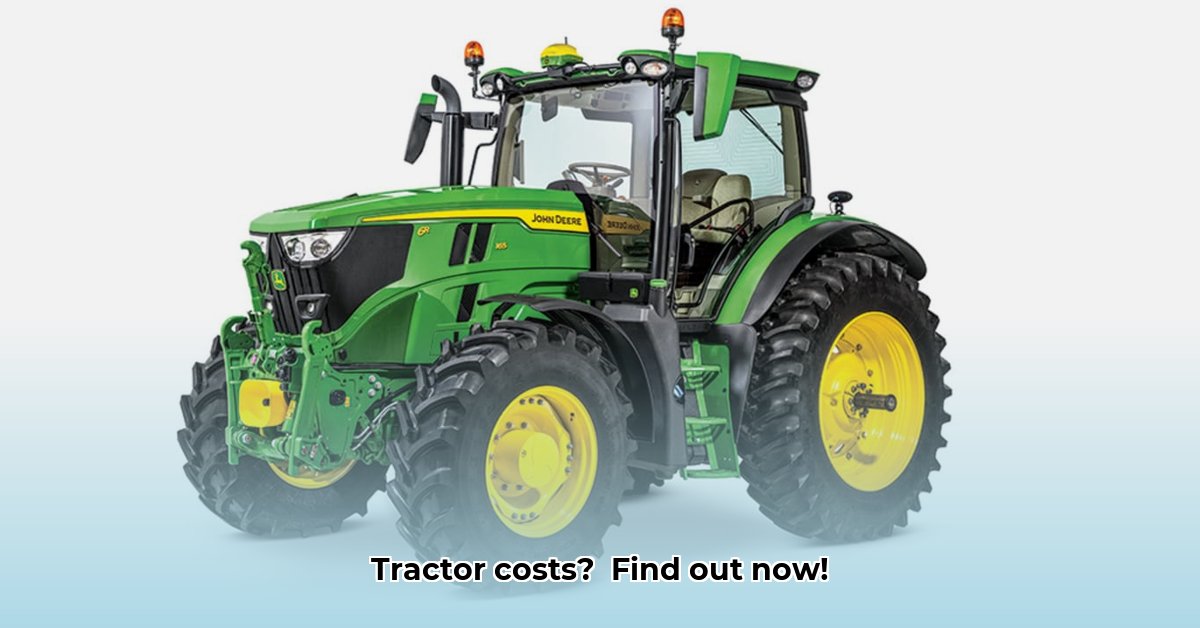
What Influences the Price of a New Tractor?
The cost of a new tractor varies dramatically, ranging from tens of thousands to over half a million dollars. Several key factors contribute to this wide price range. Understanding these factors is crucial for making an informed purchase decision that aligns with your farm's needs and budget. For more detailed cost breakdowns, see this helpful resource on tractor costs.
- Horsepower: Higher horsepower translates to a higher price tag. A larger, more powerful tractor is necessary for extensive land coverage or demanding tasks, but comes at a premium.
- Brand: Certain brands command higher prices due to reputation, technological advancements, and perceived quality. Researching different brands allows for a cost-benefit analysis.
- Features: Advanced features like GPS guidance, automatic steering, and other technological enhancements significantly increase the cost. Evaluate whether these features are essential for your operations or if more basic models will suffice.
- Tractor Type: Specialized tractors designed for specific tasks (e.g., vineyard tractors) typically cost more than general-purpose models. Consider whether a specialized model is truly necessary or if a versatile model can better serve your diverse needs.
New Tractor vs. Used Tractor: Weighing Your Options
The decision between a new and used tractor involves a careful consideration of various factors. Both options present distinct advantages and disadvantages.
New Tractors: Offer peace of mind through warranties, incorporate the latest technology, and often boast better fuel efficiency. However, they represent a substantially higher initial investment.
Used Tractors: Provide significant cost savings upfront, but may incur higher maintenance expenses in the future. A thorough pre-purchase inspection is vital to avoid costly surprises. The age and operating hours of a used tractor significantly impact its overall condition and predicted future maintenance costs.
Renting: Renting a tractor can be a cost-effective solution for smaller farms or short-term projects, but may be less economical for year-round work.
Your Step-by-Step Tractor Buying Guide
This guide provides a structured approach to purchasing a tractor, ensuring you make a well-informed decision.
1. Assess Your Needs: Define your tractor's intended use, the size of your land, and the tasks it will perform. This assessment will dictate the necessary horsepower and features. Avoid unnecessary bells and whistles that inflate the price without providing commensurate benefits.
2. Budget Effectively: Determine your maximum budget before starting your search. Explore financing options such as bank loans and government subsidies specifically designed to support sustainable agriculture initiatives. Careful budgeting prevents overspending and ensures financial stability.
3. Research Tractors: Compare different makes and models, considering factors such as fuel efficiency, potential maintenance issues, warranty coverage, and resale value. Online resources and agricultural publications can prove invaluable during this phase.
4. Thorough Inspection (Used Tractors): If opting for a used tractor, a comprehensive inspection by a qualified mechanic is non-negotiable. It serves as a critical investment to avoid substantial repair costs later on.
5. Negotiate the Price: Don't hesitate to negotiate the price with the dealer. Many dealers have flexibility in their pricing, especially when multiple vendors are selling similar models.
6. Secure Financing: Secure financing with favorable loan terms and interest rates. Explore government programs offering subsidies for sustainable agricultural equipment. Compare offers from multiple lenders to optimize your financing terms.
7. Finalize the Purchase: Once you've made your decision, ensure all the necessary paperwork is completed accurately. This includes warranties, maintenance agreements, and other pertinent details. Retain copies of all documentation.
New vs. Used: A Quick Comparison
| Feature | New Tractor | Used Tractor |
|---|---|---|
| Upfront Cost | High | Low |
| Maintenance Costs | Generally Lower (under warranty) | Potentially Higher |
| Technology | Latest Technology | Older Technology; Potential Upgrades Needed |
| Warranty | Usually Included | Limited or None |
| Resale Value | Typically Good | Depends on Condition and Age |
Sustainability: A Key Consideration
In sustainable farming, fuel efficiency is critical for environmental stewardship. Consider tractors that use biodiesel or other alternative fuels. Precision agriculture technologies like GPS guidance significantly reduce fuel consumption and fertilizer use, benefitting both your budget and the environment. "Precision agriculture techniques can reduce fuel usage by up to 20%, according to a study published in the Journal of Agricultural Engineering Research," states Dr. Anya Sharma, Agricultural Engineer, University of California, Davis.
Minimizing Tractor Maintenance Costs
Regular maintenance is crucial for extending your tractor's lifespan and reducing repair costs. Preventative care, akin to regular checkups for your health, is essential in preventing costly future repairs.
Preventative Maintenance Steps:
- Establish a Schedule: Create a detailed maintenance schedule based on your tractor's manual and usage.
- Regular Checks: Perform routine checks (oil, tires, coolant) before each use.
- Cleanliness: Clean your tractor after each use to prevent accelerated wear.
- Fluid Changes: Follow recommended fluid change intervals.
- Professional Inspections: Schedule annual professional inspections.
Choosing the right parts (OEM vs. aftermarket) impacts both cost and longevity. Sustainable practices extend to responsible waste disposal: recycle used oil and filters. Budget effectively for maintenance; it's an investment.
The Bottom Line: It Depends
The cost of a new tractor varies significantly based on individual needs and choices. This guide helps in navigating the process and making an informed decision. Remember to account for all costs, including maintenance and financing. Continuously seek updated information and resources as technology evolves.